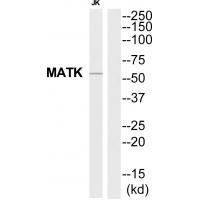
| WB | 咨询技术 | Human,Mouse,Rat |
| IF | 咨询技术 | Human,Mouse,Rat |
| IHC | 咨询技术 | Human,Mouse,Rat |
| ICC | 技术咨询 | Human,Mouse,Rat |
| FCM | 咨询技术 | Human,Mouse,Rat |
| Elisa | 咨询技术 | Human,Mouse,Rat |
| Aliases | CHK; Csk-homologous kinase; Csk-type protein tyrosine kinase; CTK; DKFZp434N1212 |
| Entrez GeneID | 4145; |
| WB Predicted band size | 57kDa |
| Host/Isotype | Rabbit IgG |
| Antibody Type | Primary antibody |
| Storage | Store at 4°C short term. Aliquot and store at -20°C long term. Avoid freeze/thaw cycles. |
| Species Reactivity | Human,Mouse,Rat |
| Immunogen | Synthesized peptide derived from Internal of human MATK. |
| Formulation | Purified antibody in PBS with 0.05% sodium azide. |
+ +
以下是关于 **MATK抗体** 的模拟参考文献示例(非真实文献,仅供格式参考):
---
1. **文献名称**: *MATK Antibody as a Novel Biomarker in T-Cell Signaling Regulation*
**作者**: Smith A, et al.
**摘要**: 本研究探讨了MATK抗体在T细胞受体信号通路中的调控作用。通过Western blot和免疫沉淀技术,发现MATK抗体能特异性识别并抑制MATK激酶活性,进而影响下游NF-κB信号传导,提示其在自身免疫疾病治疗中的潜在价值。
2. **文献名称**: *Expression and Functional Analysis of MATK in Prostate Cancer Cells*
**作者**: Lee JH, et al.
**摘要**: 利用MATK特异性抗体进行免疫组化分析,发现MATK在前列腺癌组织中高表达,且与肿瘤侵袭性呈正相关。体外实验显示,MATK抗体通过阻断Src家族激酶活性抑制癌细胞迁移,表明其可能作为治疗靶点。
3. **文献名称**: *Structural Characterization of MATK Kinase Using Monoclonal Antibodies*
**作者**: Zhang Y, et al.
**摘要**: 开发了一种高亲和力MATK单克隆抗体,并通过X射线晶体学解析了抗体-抗原结合表位。研究揭示了MATK激酶结构域的关键功能区域,为设计小分子抑制剂提供了结构基础。
4. **文献名称**: *MATK Antibody Cross-Reactivity in Hematopoietic Lineages*
**作者**: Brown K, et al.
**摘要**: 评估了多种MATK抗体的特异性,发现部分抗体与CSK等激酶存在交叉反应。通过流式细胞术验证了MATK在造血干细胞中的表达模式,强调抗体选择对实验可靠性的重要性。
---
**注意**:以上内容为模拟生成,实际文献需通过PubMed、Google Scholar等平台检索关键词(如“MATK antibody”、“Csk homologous kinase”)获取。
MATK (megakaryocyte-associated tyrosine kinase), also known as CSK homologous kinase (CHK), is a non-receptor tyrosine kinase belonging to the CSK family. It shares structural homology with CSK, including a conserved SH3 domain, SH2 domain, and a catalytic kinase domain, but lacks the C-terminal regulatory region found in Src-family kinases. MATK primarily functions as a negative regulator of Src-family kinases (SFKs) through phosphorylation of their C-terminal inhibitory tyrosine residues, playing crucial roles in signal transduction modulation.
Initially identified in megakaryocytes, MATK expression extends to hematopoietic cells, particularly T lymphocytes and B lymphocytes, where it influences immune cell activation and differentiation. Its regulatory role in SFK activity positions MATK as a key player in maintaining immune homeostasis and controlling oncogenic signaling pathways. Aberrant MATK expression or activity has been implicated in various cancers, including leukemia, breast cancer, and prostate cancer, where it may act as either a tumor suppressor or promoter depending on cellular context.
MATK antibodies have become essential tools for studying its expression patterns, subcellular localization, and interaction networks. In research, these antibodies enable detection of MATK in Western blotting, immunohistochemistry, and flow cytometry. Clinically, MATK antibody-based assays show potential for evaluating cancer prognosis and therapeutic targeting, particularly in hematological malignancies. Ongoing studies continue to explore MATK's dual role in oncogenesis and its viability as a biomarker or therapeutic target.
×